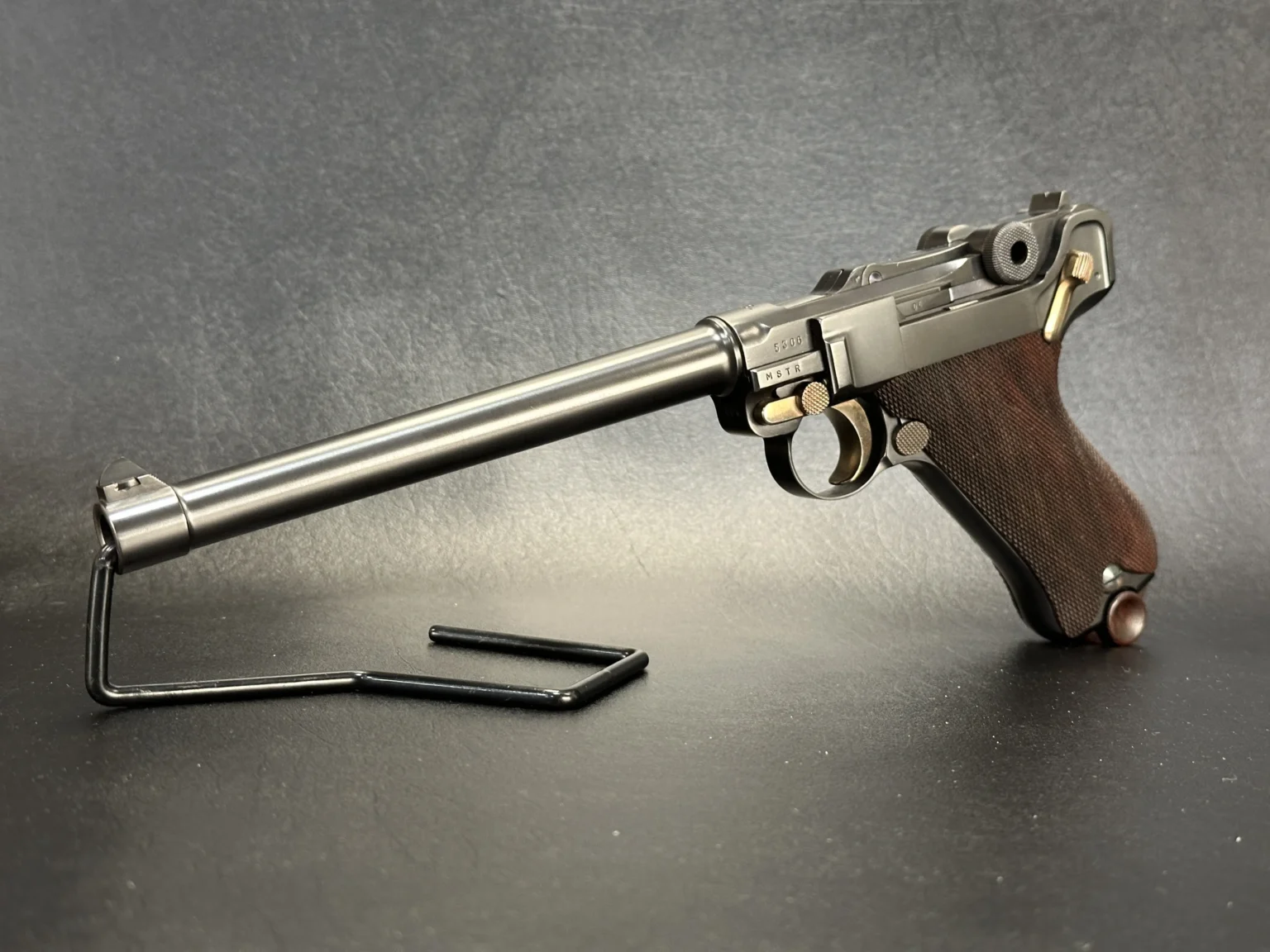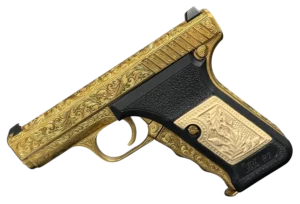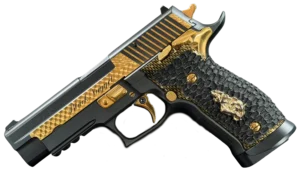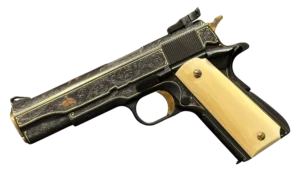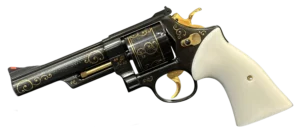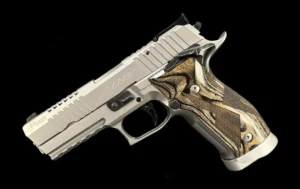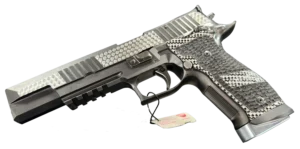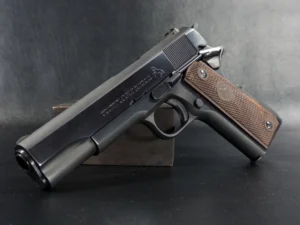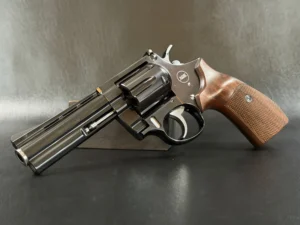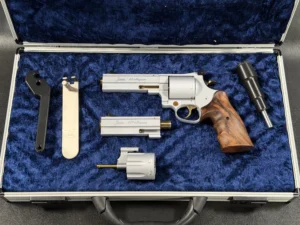For generations, the name “Luger” has held a special place in the world of firearms. Revered for its precision, admired for its innovative design, and renowned for its historical impact, the Luger pistol has achieved a legacy few other firearms can match. Known by names such as “Parabellum” in parts of Europe, the gun is celebrated globally for its engineering and mystique. The Luger’s reputation as one of the finest pistols ever made is not merely the result of opinion; it’s rooted in a story filled with groundbreaking design, military demand, and legendary creators. But what makes this pistol so enduringly popular? Why is it considered one of the “best” pistols ever made?
The story of the Luger pistol is one of innovation and adaptation, tracing back to the 19th century and the vision of two brilliant designers, Hugo Borchardt and Georg Luger. To uncover how the Luger rose to iconic status, we’ll delve into the life of its creators, the technical brilliance behind its design, and the eras that cemented its reputation. This journey through history will reveal how engineering mastery and wartime necessity combined transformed the Luger into a lasting legend in the firearm world.
The Origins: Hugo Borchardt and Early Firearms Innovation
The story of the Luger pistol begins with Hugo Borchardt, a man with a mind wired for invention and a deep interest in the mechanics of firearms. Born in Germany and later naturalized as an American citizen, Borchardt was a skilled inventor with a remarkable range of patents. Before turning his attention to firearms, Borchardt had already established himself as an engineer, creating various devices and inventions that showcased his mechanical genius. His work varied, including a machine for bullet grooving and patching, rock drilling, and even a shirt-neck shaper. Despite his many patents, Borchardt’s true legacy in firearm history would come through his groundbreaking work on semi-automatic pistols.
In the mid-1870s, Borchardt took a position with the Sharps Rifle Company, where he contributed to developing the Sharps-Borchardt rifle, an advanced breechloading firearm that would become a respected rifle model of its time. This experience cemented his reputation as a talented designer and problem-solver in the firearms industry. However, Borchardt’s ambitions reached beyond rifles; he wanted to develop a pistol that would operate semi-automatically, a feat that had yet to be achieved successfully.
By 1893, Borchardt had turned his focus to creating a semi-automatic pistol, leading to the invention of the Borchardt C-93. This pistol was unlike anything the world had seen before—a precise, intricate mechanism with a toggle-lock action that enabled rapid firing. Although groundbreaking, its design had limitations: it was large, heavy, and somewhat cumbersome to handle. Nevertheless, the Borchardt C-93 was a mechanical marvel, and it marked the beginning of the semi-automatic pistol’s journey into military and civilian use. This pistol would lay the foundation for an even more refined firearm, which would soon emerge under the guidance of a new visionary: Georg Luger.
Enter Georg Luger: The Mechanical Visionary
Following Hugo Borchardt’s footsteps, Georg Luger entered the firearms industry at a time when semi-automatic pistols were still experimental. Born in 1849 in Steinach, Tirol, Luger’s path to firearms engineering began in the Austrian Army, where he developed a strong affinity for mechanical systems. His keen interest in engineering and military experience positioned him well to explore the design challenges of early firearms. Luger soon crossed paths with Ferdinand von Mannlicher, another influential arms designer. Together, they experimented with automatic rifle designs, opening the door for Luger’s career in weapon innovation.
By the early 1890s, Luger worked for Ludwig Loewe & Company in Berlin. This company would soon merge with Deutsche Waffen und Munitionsfabriken (DWM), one of Germany’s leading arms manufacturers. It was during this time that Luger met Hugo Borchardt. Borchardt had created the first successful semi-automatic pistol, the C-93, but its impractical size and bulk hindered its widespread adoption. Despite the C-93’s groundbreaking toggle-lock mechanism, Borchardt was reluctant to modify his design to make it more user-friendly. As a result, DWM enlisted Georg Luger, whose vision for an improved semi-automatic pistol would soon transform the firearms industry.
Luger’s approach was pragmatic yet innovative. He understood the potential of the C-93’s toggle-lock system. Still, he recognized that significant modifications were needed to make the design viable for military and civilian use. With this in mind, he set out to refine Borchardt’s concept. Luger shortened the barrel and removed the cumbersome stock attachment, making the pistol lighter and easier to handle. He inclined the grip at an angle, which improved the user’s control and stability, making the gun more ergonomic. Additionally, he integrated the recoil spring within the grip rather than in a protruding housing, resulting in a more compact and balanced firearm.
By 1898, Luger’s redesigned pistol was ready for testing, quickly proving superior to existing models. His improvements turned the original C-93 into a sleek, efficient weapon with excellent balance and handling. This pistol could truly function as a practical sidearm. Luger’s refined model was so successful that it allowed him to demonstrate it before military officials in Switzerland. This prototype, often called the Borchardt-Luger, became the basis for the legendary Luger pistol dominating the early 20th-century handgun market.
The pivotal year came in 1900 when the Swiss Army adopted Luger’s pistol as its standard sidearm, making Switzerland the first to officially recognize and use the Luger. This endorsement marked a significant turning point, setting off a wave of interest in Europe and beyond. Soon, other countries began testing the Luger, and its reputation as a reliable, accurate, and innovative firearm began solidifying. The adoption by the Swiss was also the moment when the pistol earned its famous name: “Parabellum,” a Latin phrase meaning “prepare for war.”
Luger’s pistol, now officially known as the “Pistole Parabellum,” was rapidly becoming a weapon of choice for military forces around the world. With a solid foundation in design and the endorsement of a respected European military, the Luger was poised to become one of the most iconic firearms in history.
Design and Technical Innovations of the Luger
Georg Luger’s redesign of the Borchardt pistol introduced several technical innovations that set his creation apart from other firearms of the time. At the heart of the Luger’s design was the distinctive toggle-lock mechanism. This feature would become one of its defining characteristics. This system allowed the Luger to function as a semi-automatic firearm, harnessing the energy of each fired round to chamber the next round with precision and speed. Unlike traditional blowback designs, the toggle-lock system used a series of articulated joints that opened and closed smoothly, resulting in less recoil and greater control during rapid firing.
One of the most innovative aspects of Luger’s design was the grip angle, which he inclined at a 55-degree angle. This ergonomic adjustment was groundbreaking, allowing users to maintain a more natural wrist position, improving accuracy and comfort. The angled grip also helped distribute recoil force more evenly, making the Luger easier to control during repeated firing. This grip angle has since influenced modern pistol design and remains a characteristic feature of many popular firearms.
Luger’s attention to detail extended beyond the toggle-lock and grip angle. He reconfigured the internal components to create a more compact, reliable firearm. For instance, the recoil spring was moved inside the grip, eliminating the need for external housing and making the design more streamlined. This modification also contributed to the pistol’s exceptional balance, allowing for smoother handling and faster target acquisition. Additionally, Luger introduced grip safety—a mechanism that prevented the gun from firing unless firmly held. This feature was intended to avoid accidental discharges, adding a layer of protection that would become standard in many future firearms.
Another significant innovation associated with the Luger was the introduction of the 9mm Parabellum cartridge, commonly known today as the 9mm Luger. Developed in 1902, this cartridge became one of the most popular pistol rounds in the world and is still widely used over a century later. The 9mm cartridge offered an ideal balance of power and control, allowing for adequate stopping power without excessive recoil. It was a versatile round that could be used by military, police, and civilian shooters, contributing to its lasting popularity.
Luger’s technical advancements weren’t solely about performance; they were also about aesthetics and craftsmanship. Each Luger was manufactured with precision and attention to detail, making it functional and visually appealing. The DWM factory in Berlin, where the Lugers were produced, was known for its high standards, using only the best materials and ensuring every piece was meticulously assembled. The pistol’s design featured clean lines, a sleek silhouette, and a glossy finish, adding to its allure and desirability.
As a result of these innovations, the Luger pistol became highly sought after by military forces, law enforcement, and private collectors. Its unique combination of functionality, comfort, and craftsmanship established it as more than just a weapon; it was a technical and aesthetic masterpiece. With these advancements, the Luger was poised to make its mark on the global stage, drawing the attention of militaries worldwide and cementing its reputation as one of the finest handguns ever created.
The Luger’s Rise to Fame: Adoption and Global Recognition
With its groundbreaking design and technical prowess, the Luger quickly caught the attention of military forces across Europe and beyond. The first significant endorsement came from Switzerland in 1900, making it the first country to officially adopt the Luger as its standard military sidearm. This marked a significant milestone for Georg Luger and Deutsche Waffen und Munitionsfabriken (DWM), which now had a proven and marketable weapon. The Swiss model, designated the “Pistole Parabellum,” became synonymous with precision and reliability, propelling the Luger to global recognition.
Following Switzerland’s adoption of the Luger, other countries began to notice. 1901, the United States Army ordered 1,000 Lugers, marking the pistol’s first official foray into the American market. These Lugers, distinguished by an engraving of the American eagle on the chamber, were intended for testing among U.S. troops. The U.S. military’s interest in the Luger highlighted its quality, accuracy, and potential as a military sidearm, even though it was eventually passed over in favor of the Colt Model 1911. Nonetheless, the trials bolstered the Luger’s reputation and introduced the pistol to American gun enthusiasts.
As the Luger’s fame spread, Germany took note of the pistol’s potential. In 1904, the German Navy adopted the Luger as its standard-issue sidearm, marking the beginning of the pistol’s official role in German military forces. This model, often called the “Navy Luger,” featured a six-inch barrel and an adjustable rear sight designed for extended ranges. Adopting the Luger by the German Navy helped solidify its position within Germany’s armed forces, setting the stage for an even more significant role.
The actual turning point for the Luger came in 1908 when the German Army adopted it as its standard sidearm, designating it as the P08. This decision marked a historic moment for the Luger, as it would now be issued to German soldiers nationwide, from officers to enlisted men. The P08 model featured a slightly shorter four-inch barrel and was chambered in the newly developed 9mm Parabellum cartridge. This version became the most widely recognized variant of the Luger and cemented the pistol’s association with Germany’s military might.
The Luger’s adoption by Germany had a ripple effect, sparking interest from other nations eager to test its capabilities. Countries such as Sweden, Russia, Brazil, and Bulgaria conducted trials. They sometimes adopted the Luger as a military or police sidearm. The pistol’s sleek design, impressive accuracy, and ease of use made it desirable for military and civilian markets. The Luger was becoming a global phenomenon in many ways, with DWM producing and exporting it to meet the rising demand.
By the early 1910s, the Luger had become one of the most respected and recognized handguns worldwide. Its distinctive profile, with the angled grip and toggle-lock mechanism, made it instantly recognizable, and its performance on the battlefield solidified its reputation. The Luger was now more than a firearm; it symbolized precision engineering, quality craftsmanship, and military power. As Europe moved toward the brink of war, the Luger was poised to become one of the defining weapons of the early 20th century, further cementing its place in history.
The Impact of World War I: A Symbol of German Strength
When World War I erupted in 1914, the Luger pistol was already firmly established within the ranks of the German military. As the standard sidearm of German forces, the Luger quickly became a symbol of the nation’s military prowess. The P08 model, with its compact four-inch barrel and reliable 9mm cartridge, proved well-suited for trench warfare’s intense and often brutal conditions. For many German soldiers, the Luger was not only a tool of war, but also a badge of honor, and its distinctive silhouette became synonymous with German military might.
The demands of World War I placed immense pressure on German manufacturers to produce Lugers in large quantities. DWM in Berlin and the Royal Arsenal at Erfurt ramped up production to meet this demand. Both facilities worked tirelessly to equip German troops, and between 1914 and 1918, approximately two million Lugers were manufactured. This unprecedented production level made the Luger one of the most widely issued pistols of the war. It helped solidify its reputation as a durable and dependable firearm. The mass production of Lugers meant that soldiers across the German military, from officers to infantrymen, were armed with this iconic weapon.
During the war, specialized versions of the Luger were also introduced to meet the unique demands of different branches within the military. One notable variant was the “Artillery Luger,” officially designated the Lange Pistole 08 or LP08. This model featured an extended eight-inch barrel and a rear sight calibrated for distances up to 800 meters. It was often issued with a shoulder stock, which allowed soldiers to use the pistol more like a carbine, giving them greater accuracy at longer ranges. The Artillery Luger was typically paired with a 32-round drum magazine, known as the “snail drum,” providing soldiers with increased firepower. These features made the LP08 particularly suited for specialized units such as artillery crews and machine gun teams who needed a compact yet powerful firearm.
The Luger’s prominence on the battlefield did not go unnoticed by enemy forces. The pistol’s unique design and precision craftsmanship often captivated Allied soldiers. Many sought to capture Lugers as war trophies, and possessing one became a point of pride among Allied soldiers. This interest further fueled Luger’s mystique and helped spread its reputation outside Germany. For soldiers on both sides, the Luger symbolized the technological advancements that had shaped modern warfare.
Despite its effectiveness, the Luger’s complex mechanism and reliance on high-quality manufacturing made it challenging to produce in the numbers required for a prolonged conflict. As the war dragged on, German arms manufacturers struggled to keep up with the demand for replacement parts, and the high standards required to produce a Luger made it challenging to maintain consistency. Additionally, the pistol’s intricate design made it prone to jamming if not correctly maintained, a challenge in trench warfare’s muddy, harsh conditions. These factors ultimately limited the Luger’s efficiency as a mass-produced wartime weapon.
Nevertheless, the Luger endured as a trusted sidearm for German forces throughout World War I. By the war’s end, it had not only proven its worth as a reliable weapon. Still, it had also cemented its place as a symbol of German engineering and military tradition. For many, the image of a German soldier wielding a Luger became emblematic of the conflict. Although Germany’s defeat in 1918 ended the war, Luger’s legacy was only beginning, as its reputation and allure would continue to grow in the post-war years.
Post-War Changes: The Treaty of Versailles and Civilian Market
With Germany’s defeat in World War I, the production and distribution of military equipment, including the Luger pistol, came under intense scrutiny. The Treaty of Versailles, signed in 1919, imposed strict limitations on Germany’s military capabilities, including prohibiting the production of certain weapons. This treaty specifically restricted firearms with barrels longer than four inches and calibers exceeding 8mm, directly impacting the future of the Luger as a military sidearm. To comply, German manufacturers shifted their focus from military production to civilian and export markets, ushering in a new chapter in Luger’s history.
In response to these restrictions, Deutsche Waffen und Munitionsfabriken (DWM) began producing a modified version of the Luger, the “Model 1923,” specifically for export. The Model 1923 featured a shortened 3.625-inch barrel, which met the treaty’s regulations. Additionally, many were chambered in 7.65mm (.30 Luger) to comply with the caliber restrictions. Though designed to adhere to the treaty’s terms, the Model 1923 preserved the iconic look, feel, and function of the Luger, making it highly desirable to civilians and collectors worldwide.
The Model 1923 quickly gained popularity in countries where firearms ownership was legal for civilians. In the United States, where the Luger had already gained a following among enthusiasts, DWM found a receptive market. This period marked the beginning of Luger’s transformation from a military sidearm into a collector’s item and a symbol of fine German craftsmanship. The high-quality materials and precision engineering that went into each Luger continued to set it apart, and demand grew not only for newly manufactured models but also for surplus military Lugers brought back by soldiers as war souvenirs.
In addition to the United States, the Model 1923 succeeded in South America, particularly in Brazil and Argentina, where law enforcement agencies adopted it as a standard sidearm. DWM’s ability to adapt the Luger to meet international needs showcased its versatility and helped it secure a foothold in civilian and law enforcement markets across the globe. The Luger’s reliability and distinctive design made it popular among police and security forces, adding to its reputation as a dependable firearm.
Another noteworthy development during this period was the introduction of “double-date” Lugers. With Germany’s restricted military force capped at 100,000 soldiers, existing Lugers from World War I were issued to the newly organized German police and the army units. To signify their reissue, these pistols were marked with a second date, usually “1920,” above the original date of manufacture. These “double-date” Lugers are now sought-after collector’s items, representing a unique moment in the pistol’s history as it transitioned from a wartime weapon to a post-war artifact.
Despite the restrictions the Treaty of Versailles imposed, Germany found creative ways to maintain a modest arms industry. In 1922, the Simson & Co. firm in Suhl, Germany, was granted a license to produce a limited number of Lugers for the Reichswehr, Germany’s official military, under the treaty’s terms. These “Simson Lugers” were assembled from surplus military parts and were marked with the Simson logo, differentiating them from DWM-produced models. Today, Simson Lugers are considered rare and are highly valued among collectors.
As the post-war years unfolded, the Luger continued to evolve. Civilian demand for the pistol remained strong, driven by its reputation and availability on the surplus market. In many ways, the Luger’s post-war period marked a second life for the pistol. Its association with German engineering and its availability in various models and calibers ensured its place not only as a historical artifact but as a prized firearm for civilian shooters and collectors worldwide.
The Treaty of Versailles might have ended the Luger’s official role as Germany’s standard military sidearm. Still, it did nothing to diminish its appeal. Instead, the treaty inadvertently fueled its mystique, giving rise to a new wave of enthusiasts who saw the Luger as a weapon and a piece of history. This period of adaptation and reinvention allowed the Luger to survive the post-war years and maintain its legacy, setting the stage for further innovations and a renewed role in German rearmament efforts in the 1930s.
Resurgence and Variations: The Mauser and Krieghoff Lugers
In the early 1930s, Germany was on the path to rearmament, and the Luger pistol again found itself at the center of the nation’s military strategy. As the Treaty of Versailles restrictions began to relax and then crumble under the new political regime, German manufacturers resumed full-scale production of firearms, including the Luger. This period saw a resurgence in the Luger’s prominence and several notable variations that intrigue collectors and historians.
One of the most significant developments during this era was the transfer of Luger production from DWM to Mauser-Werke in Oberndorf. In 1930, Mauser took over the production line and tooling for the Luger from DWM, which shifted its focus toward ammunition manufacturing. Mauser, known for its legendary firearms, was well-equipped to handle Luger production and quickly established itself as the primary supplier. Mauser Lugers retained the same quality and precision as their predecessors while introducing subtle design and marking changes to distinguish their models.
Under Mauser’s production, the Luger continued to evolve, with new markings and serial codes introduced to reflect the shifting priorities of the German military. In 1934, German arms manufacturers began using coded designations to mask production sources from foreign intelligence agencies. Mauser Lugers from this period were marked with “S/42,” a code representing Mauser’s factory, instead of the traditional DWM logo. This was later changed to “42” in 1939 and then to “by” in 1941, further obscuring the pistol’s origins. These coded Lugers were produced in 9mm and 7.65mm calibers. They were often marked with date stamps over the chamber, indicating the year of manufacture.
Another prominent variation from this era came from the Krieghoff Waffenfabrik, a small but distinguished arms manufacturer in Suhl, Germany. Krieghoff specialized in producing high-quality firearms for the Luftwaffe, Germany’s air force, under the direct supervision of Hermann Göring. Krieghoff Lugers, manufactured primarily for Luftwaffe personnel, featured the company’s distinct trademark—an anchor with a dagger and the initials “HK” on the toggle link. These pistols were typically produced in limited quantities, each held to exceptionally high manufacturing standards.
Krieghoff Lugers are among the rarest and most sought-after variants today due to their limited production numbers and connection to the Luftwaffe. These pistols were meticulously crafted, with a fit and finish that surpassed even the high standards of Mauser Lugers. In addition to their unique markings, Krieghoff Lugers often included specialized features such as extra polishing and engraved details. Some models were produced for the civilian market. Still, the Luftwaffe used the vast majority, adding to their historical and collectible value.
The 1930s also saw the creation of several experimental and commemorative Luger models. For instance, the “K Date” and “G Date” Lugers were marked with letter codes to obscure their production dates and circumvent international German rearmament regulations. Additionally, Mauser produced a limited number of Lugers for the commercial market, distinguished by the Mauser “Banner” logo on the toggle link. These commercial Lugers are prized today due to their rarity and pristine condition, as many were never used in military service.
By the end of the 1930s, Mauser’s production capabilities were fully dedicated to supplying the German military, with civilian sales essentially halted as World War II loomed. The Luger was once again a staple of the German armed forces, issued to officers and specialized units. This period marked the Luger’s resurgence as a symbol of German strength and innovation, and its presence on the battlefield would once again cement its place in military history.
Mauser continued to produce Lugers throughout World War II. However, production began to decline in favor of the Walther P38, a newer, simpler, and faster manufacturing design. The transition to the P38 marked the beginning of the end for the Luger’s role as a German military sidearm. However, the variations produced during the Mauser and Krieghoff years, with their unique markings, high quality, and historical significance, continue to be some of the most collectible and valued Lugers today.
WWII and Beyond: The End of an Era
As World War II unfolded, the Luger was again thrust into the spotlight, serving as a standard-issue sidearm for German forces. However, while the pistol remained highly regarded for its precision and historical significance, its complexity and labor-intensive production process were increasingly seen as drawbacks. In response, the German military began looking for a more efficient alternative to meet wartime production demands. This search led to the adoption of the Walther P38 in 1938, a more straightforward and cost-effective design that eventually replaced the Luger in standard military service.
The Walther P38, with its more straightforward blowback mechanism and fewer parts, was more accessible to manufacture and maintain, making it ideal for large-scale production during the war. The Luger’s role gradually shifted as the P38 began to roll off assembly lines in more significant numbers. Although it remained in use, particularly among officers and specialized units, production of the Luger declined as resources were redirected toward producing the newer model. By 1942, Mauser ceased large-scale Luger production, marking the end of an era for one of Germany’s most iconic firearms.
Despite its replacement, the Luger retained its allure and respect on the battlefield. Much like those in World War I, Allied soldiers were captivated by the pistol’s unique design and precision engineering. Capturing a Luger became a coveted prize for many Allied troops, and it was not uncommon for returning soldiers to bring these pistols home as war trophies. The Luger’s status as a symbol of German engineering and its aesthetic appeal only increased its value among collectors and enthusiasts in the post-war years.
Following Germany’s defeat in 1945, a small number of Lugers were assembled from surplus parts under the oversight of Allied occupation forces. These post-war Lugers, often assembled at the Mauser factory under French control, were primarily used by occupation troops or distributed as souvenirs. This final production phase was limited, and these post-war Lugers are considered rare and historically significant, as they represent the last chapter of the pistol’s long production history in Germany.
In the years following World War II, the Luger continued to capture the imaginations of firearm collectors, historians, and shooting enthusiasts worldwide. Although it was no longer produced, its reputation as one of the finest and most iconic pistols ever made remained intact. Many former soldiers who had encountered the Luger during the war sought it out as a collector’s item, and demand for the pistol surged, especially in the United States. Recognizing this demand, the American company Stoeger Arms obtained the rights to the Luger name. They began importing surplus Lugers and manufacturing new models under the brand “American Eagle.”
Luger’s post-war legacy also significantly impacted firearms design. Its ergonomic grip angle, toggle-lock mechanism, and overall balance influenced future generations of handguns, inspiring designers worldwide. Although the toggle-lock system was too intricate for mass production in modern contexts, its influence is still evident in competition pistols and custom firearms design, where precision and craftsmanship are prioritized.
Switzerland, which adopted the Luger as its standard-issue pistol in 1900, continued to manufacture its own versions well into the mid-20th century. The Swiss government maintained the Luger as its primary sidearm until 1948 when it was eventually replaced by the SIG P210. This long tenure is a testament to the pistol’s durability, reliability, and the high regard in which military forces held it.
By the late 20th century, the Luger had firmly established itself as a classic, with various models highly prized by collectors. The scarcity of specific models, particularly pre-war and wartime variations, only added to its mystique. As the years passed, the Luger transformed from a symbol of military power into a coveted collector’s item, representing a bygone era of craftsmanship and innovation.
The end of the Luger’s production marked the close of one of the most fascinating chapters in firearm history. While it was eventually replaced in military service, Luger’s legacy is a remarkable blend of artistry, engineering, and cultural impact. Its journey from the battlefields of two world wars to the glass cases of collectors’ displays is a testament to its enduring appeal. Though production ceased decades ago, the Luger remains celebrated worldwide as one of the most influential and iconic handguns ever created.
Legacy and Collectability: The Luger’s Enduring Appeal
The Luger pistol’s legacy endures long after its production ended, resonating with collectors, firearm enthusiasts, and historians alike. Today, it is regarded not only as a revolutionary firearm but also as a piece of art emblematic of German engineering and craftsmanship. Its innovative design, historical significance, and the scarcity of certain models have made the Luger one of the most sought-after collector’s items in the firearm world.
Collectors prize the Luger for its intricate mechanical design, unique toggle-lock action, and historical connections. Numerous variants have been produced over its long lifespan, each telling a different story—from early Swiss and German military-issue pieces to rare Krieghoff and Mauser Banner-marked models. Wartime variants, especially those from World War I and II, hold particular appeal, as they are linked to pivotal historical moments. Each marking, serial number, and engraving reveals the pistol’s past, adding to its mystique and collectible value.
One of the rarest and most valuable models is the .45-caliber Luger, produced in minimal numbers for U.S. Army trials in 1907. Only a few of these pistols were ever made, and today, they are among the most coveted firearms, fetching hundreds of thousands of dollars at auction. Other prized models include the “American Eagle” Luger, a commercial version sold in the U.S. with an engraving of the American eagle on the chamber, and the “Carbine” Luger, a longer-barreled variant equipped with a wooden stock intended for long-range shooting.
Beyond its collectible value, the Luger also holds a special place in popular culture. It has appeared in countless films, television shows, and literature, often symbolizing power, precision, and European sophistication. The pistol’s distinct look—marked by its angled grip, toggle-lock action, and sleek profile—makes it instantly recognizable, even to those with little knowledge of firearms. It is often portrayed as the sidearm of choice for villains and officers in period films, reinforcing its association with history and intrigue.
The Luger’s influence on firearm design also extends to modern pistols. Its ergonomic grip angle, for example, has inspired countless designs, setting a standard that remains prevalent today. The 9mm Parabellum cartridge, developed for the Luger in the early 20th century, remains one of the most popular handgun calibers globally, used by military and police forces and civilians. In this way, the Luger’s impact is still felt in the world of firearms, as its design elements continue to shape modern pistols.
For many enthusiasts, owning a Luger is more than possessing a firearm; it is about connecting with a piece of history. Each Luger carries the legacy of its designers, Hugo Borchardt and Georg Luger, and reflects the craftsmanship and innovation of its time. It represents a period when firearms were not only tools of war but also expressions of mechanical ingenuity and artistry. This blend of history, artistry, and engineering makes the Luger a treasured and revered item among collectors worldwide.
The Luger’s value has only grown over time as a collector’s piece. Auctions and firearm exhibitions regularly feature rare models, and prices often reflect each piece’s rarity and historical significance. For those lucky enough to own one, the Luger is an investment and a symbol of one of the most fascinating chapters in the history of firearms. It is a testament to the timeless appeal of a pistol that has transcended its original purpose, becoming a symbol of craftsmanship and legacy.
In the world of firearms, few names carry the weight and recognition of the Luger. From its early days as a revolutionary sidearm to its role as a prized collectible, the Luger has left an indelible mark on firearm history. Its legacy lives on not only in collections and museums but also in its continued influence over modern handgun design. The Luger’s story is one of innovation, history, and enduring appeal, ensuring that it will always remain one of the most iconic firearms in history.
Frequently Asked Questions
The Luger pistol is famous for its unique design, precision engineering, and historical significance. It introduced the world to the 9mm Parabellum cartridge, which remains one of the most widely used handgun rounds today. Its toggle-lock mechanism, angled grip, and aesthetic appeal set it apart, making it one of the most iconic firearms in history.
German designer Georg Luger developed the Luger pistol in the late 19th century. He improved upon the earlier design of the Borchardt C-93 pistol, making it more compact and user-friendly. His modifications resulted in the iconic Luger we recognize today.
The Luger pistol is often called the “Parabellum” because Deutsche Waffen und Munitionsfabriken (DWM) marketed it under the name “Pistole Parabellum.” The term “Parabellum” comes from the Latin phrase Si vis pacem, para bellum, meaning “If you want peace, prepare for war.”
The 9mm Parabellum cartridge, also known as 9x19mm or 9mm Luger, was developed for the Luger pistol in 1902. This cartridge became extremely popular due to its balance of power and control, making it suitable for military and civilian use. It remains one of the most widely used handgun cartridges in the world.
The Luger pistol was adopted by several countries, with Germany and Switzerland being the primary users. Germany officially adopted it in 1908 as the P08, and it became a standard sidearm during both World Wars. Switzerland also adopted it as their standard-issue pistol in 1900. Other countries, including Sweden, Brazil, and the United States, conducted trials with the Luger and sometimes issued it to their military or police forces.
Lugers are popular among collectors due to their historical significance, innovative design, and craftsmanship. Each variant and marking on a Luger tells a unique story, from its military service to its place of manufacture. Their scarcity, especially for specific models like the Krieghoff or Navy Lugers, also adds to their collectible value.
“Double-date” Lugers were initially manufactured during World War I and then reissued in the post-war period. They carry two dates on the chamber: the original manufacturing date and a reissue date, usually “1920,” indicating their reallocation to the police or military under the restrictions of the Treaty of Versailles.


